Browse by Product
|
CASE STUDIES > Saggy, Deteriorating Netting a Welcome Mat for Swallows
Saggy, Deteriorating Netting a Welcome Mat for Swallows |
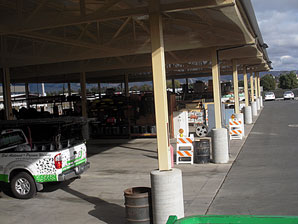
Property:Commerical
Material used: Hot Foot knotless netting
Proprietary hardware
Find out more about Hot Foot InvisiNet Exclusion Netting or contact us to learn how Hot Foot can help you get rid of pest birds for good.
The Problem
As anyone who has a swallow problem knows, once they've nested in or around your property, you can't get rid them until they fly away on their own. Swallows are migrating birds and therefore a protected species. Disturbing them or destroying their nests, if occupied, carries stiff fines.
This pubic authority knew that, and took steps to exclude the swallows from the rafters of their large nine-bay storage canopy (Image 1).
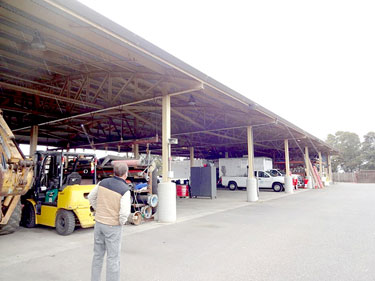 Image 1
Image 1A smart move, but over time they found out that their "generic" exclusion strategy didn't quite work for their circumstances. First, the traditional knotted polyethylene netting they had installed had several issues. The net had sagged, some sections were torn, and rodents and squirrels had chewed others, leaving large holes where animals and birds could access.
Further, the netting had been installed with cheaper hammer-on clips to anchor the netting. Over time, the clips had stretched too and were popping off. This led to even larger perimeter gaps in the cable allowing the swallows to enter.
And what a mess they made. Each spring, the swallows easily flew through the gaping holes in the netting to nest under the canopy. This resulted in a covering of mud, fecal matter, and a host of other debris on the equipment, parts, and ground. Not only was the swallows' activity damaging equipment, it led to unsanitary work conditions for the crew working below.
Rather than simply patch the deteriorating netting, the public authority decided to start from scratch and put the job out to tender in a competitive open bid process. We are proud to say that Hot Foot's recommendations won that bid. Here's how we did it.
Hot Foot's Solution
The first order of business was to remove all the old netting and hardware, and completely clean the area after the swallows had flown away. This netting was replaced with our more advanced knotless polypropylene netting (in beige, to better blend in with the surrounding structures), which is guaranteed to never stretch or sag over the 10-year life of the product. This is almost three times more than the guarantee on the corresponding beige knotted netting, for a longer-lasting solution.
One of the problems with the previous installation was that all it took was one or two holes to compromise the whole canopy. The structure is actually sub-divided into nine individual bays measuring 75ft by 25ft wide. What we recommended was to protect each bay individually with its own netting. That way, if the netting surrounding one bay was damaged (including through the activities of this busy truck and equipment storage area below), possible intrusion would be limited to the one bay and not all of them.
There were other challenges. For one, the canopy was designed in such a way that each of the 18 I-beams extended out from the edge of the canopy's roof (Images 2 and 3).
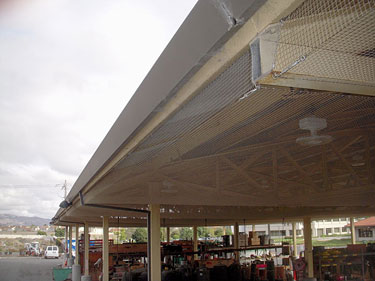 Image 2
Image 2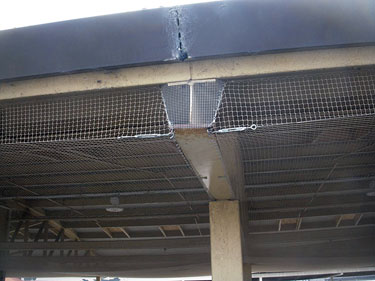 Image 3
Image 3Simply installing the netting over the edges of these I-beams was not ideal since the polypropylene would rub on the edges of the steel beam and eventually cause tears due to abrasion. Instead on our recommendation, the installer capped the I-beams with a metal mesh. The knotless bird netting was then attached to the edge sections using stainless steel hog rings, effectively wrapping the sides of the I-beam flush with the roof edge. The I-beam still juts out of course, but the netting and mesh act together to exclude birds in a way that will not abrade the netting.
Images 4 and 5 show how the netting had to be wrapped tightly around rectangular and tubular steel supports under the canopy.
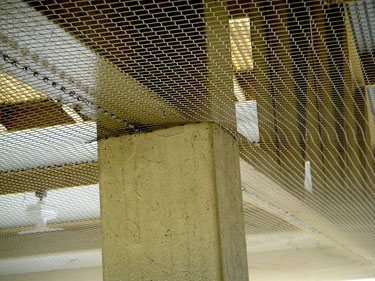 Image 4
Image 4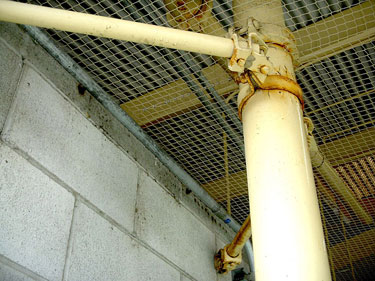 Image 5
Image 5This required cutting the net around the obstacles then re-joining tightly so that no more than a 3/4" gap was present at any one point. (Nice work by the technician in keeping the net in a square mesh pattern!)
Image 6 provides a little more insight on how this was done using the special S-Hooks manufactured by Hot Foot. These are attached to the steel beams by "shooting" a steel nail into the steel beams using a powder-actuated tool (such as a Hilti Gun).
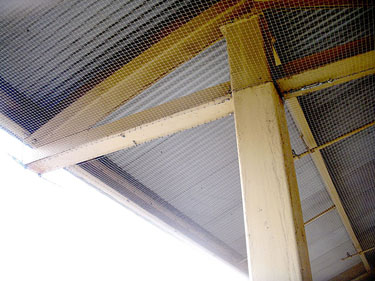 Image 6
Image 6
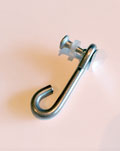
Image 7
Finally, we had to exclude swallows and animals from under the eaves of the canopy at one spot. Animals tend to make holes at spots very close to the building walls where they can stand and grip while they chew, so particular attention had to be paid to those areas. With no soffit installed, the public authority had simply enclosed the eaves with netting as well. Image 8 shows where rodents or squirrels had chewed holes to gain entry. Image 9 shows the same area but with 1/4" metal mesh installed to prevent chewing access. The metal mesh was attached using self-tapping screws and then joined to the knotless net as shown.
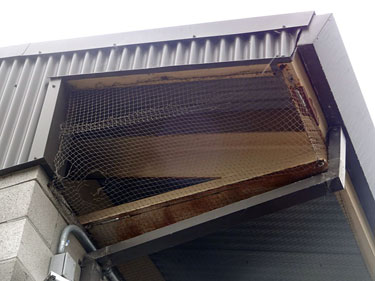 Image 8 (Before)
Image 8 (Before) Image 9 (After)
Image 9 (After)The Results
In four words: night and day difference. The installation project was completed in time for the swallows' return in the spring 2015. But they won't be returning to this canopy any more. Hot Foot's superior products combined with their expert installation knowledge helped make this project a success for years to come. It's important to note too that Hot Foot's solution wasn't likely the "cheapest" solution - at least in terms of project costs. However in the long run it will be the most inexpensive option. Proper installation and our 10-year guarantee means that this netting solution will still be in place years after our competitors' warranties run out.
In other words, if you're looking for the lowest Total Cost on Investment (TCI) for your own swallow or bird exclusion project, Hot Foot can provide you with one of the most cost-effective solutions available. Do it once. Do it right.
Contact us for a quote or find out more about how Hot Foot helps commercial, industrial, and government clients.


